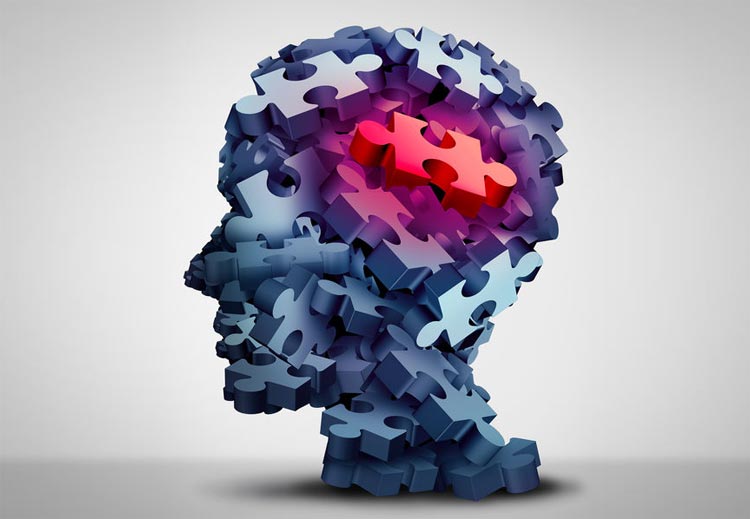Brian seemed perfectly fine, until about a year ago. That’s when you, his mother, noticed some changes take place. You understand now that you should have said something. But things are never so clear in the moment, and after all, you didn’t want to make a big deal over nothing. If only you had checked on him. Maybe things wouldn’t have gotten so entirely out of hand.
About three months ago, all of your fears and suspicions were confirmed. Brian quit his job and left college, taking a medical leave after attempting to commit suicide. Since then, his symptoms have worsened. He can’t cope with the idea of going back to school or work, he never socializes, and he rarely leaves his bedroom. Despite his initial reluctance, you convinced Brian to speak to a psychologist, who might be able to give you both a clearer idea of what’s wrong. After the session, the psychologist, with Brian’s permission, informs you that Brian is likely suffering from schizophrenia. As soon as she starts describing the symptoms of the disorder, you see all of the ways that the diagnosis accounts for the changes you’ve seen in Brian.
Shortly before graduating from high school, you tell the psychologist, as Brian was finishing finals and applying to colleges, he became a lot quieter and less excited by life. At first you thought it was a bout of depression (Brian struggled with Major Depressive Disorder in his teens), but soon you realized it was something different. He spoke in a monotone, rarely looking you in the eye, and didn’t seem interested in anything. Sometimes when you were having a conversation, he would stare, not at you, but through you, and he wouldn’t move a muscle. He seemed to be elsewhere, looking at or listening to something imperceptible to you, which had him in a trance. These unsettling episodes usually only lasted a minute or so, but during them, Brian seemed to literally see ghosts. Sometimes he would mutter unintelligible things under his breath, apparently to himself or to… whatever he saw and heard. And when these episodes passed, he would deny them.
Occasionally, when he didn’t hear you coming, you would walk in to a room to find Brian staring at a wall, talking loudly and rapidly, as though he were arguing with an invisible presence. Nothing he said made any sense to you. You were never one to believe in the supernatural, but witnessing such episodes was nothing short of bone-chilling. The month before he left for college was the worst. It seemed hardly an hour went by without something ‘unusual’ happening. Still, you tried to dismiss Brian’s weird behaviors as symptoms of stress. You assumed that once he was away, starting a new chapter of his life, Brian would go back to normal. As his recent suicide attempt proved, this didn’t work out as you hoped it would.
How, you ask the psychologist, are you to help your son? What is this illness? (“Isn’t this what ‘psychos’ have?” you ask. “People who are really crazy? Even violent?”) What treatment options are available? How is your family to cope?
What Is Schizophrenia?
As I’ve said in previous articles, the first step to combating any illness is to gain a better understanding of it. What exactly is schizophrenia?
Schizophrenia is a psychiatric illness listed under “Schizophrenia and Other Psychotic Disorders” in the DSM-V. The diagnostic criteria is sometimes difficult for non-mental health professionals to understand, so I have attempted to break down/rephrase the symptoms as simply as possible.
The primary features of schizophrenia are ‘active-phase symptoms’. To receive a schizophrenia diagnosis, the person must experience at least one of the following symptoms:
- Delusions: Irrational beliefs held, despite evidence clearly contradicting them (American Psychiatric Association, 2013). Example— Someone who believes that his teeth are made of grape jelly, despite clear evidence to the contrary.
- Hallucinations: Sensory experiences that appear real but do not actually exist. Auditory hallucinations are most common with schizophrenia (American Psychiatric Association, 2013). Examples—Looking out a window and seeing a clown staring back at you, which nobody else can see; Hearing the voice of a monster screaming at you to kill yourself, which no one else hears.
- Disorganized speech: Difficult or impossible to understand communication (American Psychiatric Association, 2013).
Additionally, those who have only one of the above symptoms must also experience at least one of the following ‘active-phase symptoms’:
- Extremely disorganized or catatonic behavior: This criteria varies greatly, depending on the person. One might behave child-like or act out aggressively. It sometimes involves excessive movements, agitation, freezing in place, or not responding to communication (American Psychiatric Association, 2013; Brazier, 2020). Catatonia usually involves a lack of movement or communication, but can include agitated, confused, or restless behavior (Bhandari, 2021).
- Negative symptoms: In this case, ‘negative’ means ‘lacking’ or ‘lessening’ (American Psychiatric Association, 2013). Examples— A lack of emotional expressiveness (blunt affect), few facial expressions, a flat speaking tone, few physical gestures, a lack of motivation or interest in things or people, depressive symptoms, and apathy towards learning.
Basically, ‘active-phase symptoms’ are broken into two categories. To receive the diagnosis, the person must have at least one from the first category. Those who only have one symptom from the first category must also have at least one symptom from the second category.
‘Active-phase symptoms’ are present for the majority of the time over the course of at least one month (or less if the disorder is successfully treated) in people with schizophrenia (American Psychiatric Association, 2013). From the disease’s onset, an individual with schizophrenia struggles to function in daily life. As Brian’s example shows, schizophrenia affects the individual’s ability to keep up with daily tasks in areas such as school and work (American Psychiatric Association, 2013). Many neglect their relationships and self-care. At least one area of functioning must be disturbed as a result of the disease’s symptoms for a significant portion of the time since the disease’s onset for the diagnostic criteria to be met (American Psychiatric Association, 2013).
Additionally, those with schizophrenia experience signs of the disease for at least six months, which includes at least one month of ‘active-phase symptoms’ (American Psychiatric Association, 2013). When the ‘active-phase symptoms’ are not acute, the person may experience early signs of the ‘active-phase symptoms’ before an episode starts or the residual effects of the ‘active-phase symptoms’ once the episode has passed (American Psychiatric Association, 2013). During these non-acute periods, the symptoms of schizophrenia are milder and/or ‘negative’ (as the term is defined under ‘active-phase symptoms’) (American Psychiatric Association, 2013).
It is sometimes difficult for mental health professionals to determine whether an individual has schizophrenia or a different, similar psychiatric disorder, such as schizoaffective disorder or mood disorders (i.e., MDD or bipolar) with psychotic features. These disorders must be ruled out before a diagnosis of schizophrenia is given (American Psychiatric Association, 2013). Mental health professionals do so by determining either that the person’s ‘active-phase symptoms’ do not occur at the same time as mood disorder symptoms; or that, if they do occur at the same time, mood symptoms occur minimally during the six-month period of schizophrenic disturbance (American Psychiatric Association, 2013).
Similarly, professionals must be careful in giving a schizophrenia diagnosis to individuals who have a history of autism spectrum disorder or a communication disorder. In these cases, the professional must determine if prominent delusions or hallucinations (as well as the other diagnostic criteria) are present for at least one month (American Psychiatric Association, 2013). In other words, the schizophrenic symptoms present in these individuals cannot solely be related to unusual speech or communication patterns, which are attributable to the disorders with which they have already been diagnosed (for example, autism spectrum disorder) and thus are not the result of schizophrenia.
Lastly, in order to receive the diagnosis, the symptoms cannot be the result of substance use or a different medical problem (American Psychiatric Association, 2013).
Most who are diagnosed with schizophrenia first develop symptoms between their teens and early thirties (American Psychiatric Association, 2013). The peak age at onset of the first psychotic episode is early- to mid-twenties (American Psychiatric Association, 2013). About twenty percent of people with schizophrenia attempt suicide at least once (American Psychiatric Association, 2013). Five to six percent of people with schizophrenia successfully complete suicide (American Psychiatric Association, 2013). The majority of individuals with this disorder will not be fully cured, but approximately twenty percent experience favorable outcomes of treatment, gaining enough control to function in many areas of their lives (American Psychiatric Association, 2013).
A Personalized Look at Schizophrenia
Above I have given a very cut-and-dried, clinical description of schizophrenia. To gain a more personalized understanding of the disorder, I’d recommend checking out the work of writer and mental health teacher Lori Schiller. In her memoir The Quiet Room, Schiller outlines her own battle with schizophrenia, which began when she was seventeen. She describes her “journey out of the torment of madness” from the very beginning of her symptoms—the hallucinations, the fear of being evil and/or possessed, the derailment of her educational and professional plans, social isolation, substance abuse, suicide attempts, the emotional struggle and guilt her family faced (wondering if they somehow caused her illness to develop), and the endless series of hospitalizations and medications she endured before finding a treatment that worked for her (Schiller & Bennett, 1994). To be clear, individuals with schizophrenia will likely always have the illness and will require medication and psychotherapy to manage their symptoms. Still, with the help of her family and psychiatric professionals, Schiller eventually found a way to control her illness and to live a full life dedicated to demystifying schizophrenia. What could be more inspiring than that?
Schizophrenia Therapy and Treatment
Unlike other psychiatric conditions, schizophrenia is extremely difficult, if not impossible, to effectively treat without medication. The reason for this is the role that brain chemicals play in the development of symptoms. An excess of neurotransmitters, such as dopamine and serotonin, cause many of the psychotic symptoms that people with schizophrenia experience (Kaufman, 2010). Medications called antipsychotics are used to block the absorption of these excess neurotransmitters within the synaptic gap between neurons (Kaufman, 2010). To say this simply, antipsychotics (as the name suggests) prevent psychosis, or losing touch with reality. This alone makes living with schizophrenia much easier.
In past decades, many people with schizophrenia have resisted treatment, due to the unpleasant side effects of the medication available (known today as first-generation antipsychotics) (“Schizophrenia,” 2020). Fortunately for twenty-first century people living with schizophrenia, there are new and improved medications (second-generation antipsychotics) available, which offer the same benefits of older medications without the negative side effects (“Schizophrenia,” 2020). Such medications include Aripiprazole (Abilify), Brexpiprazole (Rexulti), Clozapine (Clozaril, Versacloz), Quetiapine (Seroquel), among many others (“Schizophrenia,” 2020).
Besides antipsychotics, many with schizophrenia take other classes of medication, such as antidepressants (for example, SSRIs or SNRIs) to deal with the negative mood symptoms resulting from having such a debilitating mental illness (“Schizophrenia,” 2020). Beyond medication, many engage in psychotherapy, developing new ways to cope with their illness, learning more about what their illness is (psychoeducation), and participating in social skills training to develop stronger communication abilities (“Schizophrenia,” 2020). Others engage in family therapy, which helps everyone in their support system to better understand the illness and discover new ways of supporting their loved one as he/she fights the disease (“Schizophrenia,” 2020). Still others seek out vocational rehabilitation services, which helps them prepare to find and hold jobs (“Schizophrenia,” 2020).
In Conclusion …
Schizophrenia is one of the most debilitating, misunderstood, highly stigmatized mental disorders. The reason for this is because most people do not truly understand what this disorder is. The more people learn about schizophrenia, the more compassionate, patient, and understanding they will become. As we fight to understand rather than to stigmatize mental disorders, the higher our chances are of finding new, more effective cures. In the meantime, let’s make the resolution to treat everyone (including those with schizophrenia) with the same level of respect and dignity that we like to receive ourselves.
Courtesy: Gwendolyn Brown, M.S..
Ready to find your therapist? Search the Jax Therapy Network and find therapists specializing in schizophrenia near you.
Resources:
- American Psychiatric Association. (2013). Diagnostic and statistical manual of mental disorders (5th ed.)
- Anderson, N. E. & Kiehl, K. A. (2014). Psychopathy: Developmental Perspectives and their Implications for Treatment. Restor. Neurosci. 32(1), 103-117. Doi: 10.3233/RNN-139001
- Bhandari, S. (2021, Jan. 26). What Is Catatonia? WebMD
- Brazier, Y. (2020, Oct. 13). What is disorganization in schizophrenia? Medical News Today
- Kaufman, C. (2010). The Writer’s Guide to Psychology. Fresno, CA: Quill Driver Books.
- Schiller, L. & Bennett, A. (1994). The Quiet Room: A Journey Out of the Torment of Madness. New York, NY: Warner Books Edition.
- “Schizophrenia” (2020, Jan. 07). Mayo Clinic.






